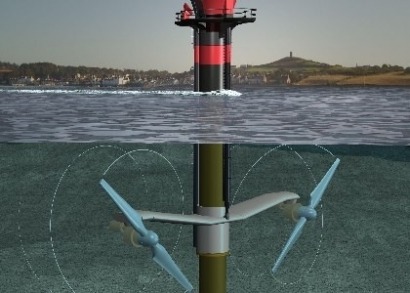
Marine Current Turbines (MCT) has evolved from a pioneer to a technology leader in horizontal axis marine current turbines and now has 25 employees. In February 2010, Siemens acquired a minor stake in the Bristol-based company and thus entered the marine tidal current market. Financial details of this month’s announcement have not been disclosed, although it has been revealed that Siemens has increased its stake in the ocean energy developer to 45%.
“With this increase in its stake, Siemens is strengthening its activities in ocean power generation. We will actively shape the commercialization process of innovative marine current power plants,” said Michael Axmann, CFO of the newly founded Solar & Hydro Division within Siemens’ Energy Sector.
Ocean power is emerging with strong growth rates driven by global carbon dioxide reduction commitments. Until 2020, experts anticipate double-digit growth rates for the ocean power market. Based on further estimates the global potential for power generation using tidal power plants is 800 terrawatt-hours (TWh) per annum. For comparison, that is equivalent to between three and four percent of power consumption worldwide.
“Through the expansion of the partnership with Siemens, we have further strengthened our position in the tidal energy market. We have the increased backing of a major industrial player which is essential to support the commercialization of our proven technology,” explained Dr Andrew Tyler, CEO of MCT. “We are about to approach investors to secure funding for our first two tidal array projects, and Siemens’ increased investment as well as UK Government support should give investors the confidence that we have the necessary backing to deliver these crucial projects and the ones to follow.”
MCT plans to present two Project Investment Prospectuses to the market within the next month for its 8 megawatts (MW) Kyle Rhea project in Scotland and its 10 MW Anglesey Skerries project in Wales. For both projects, applications for leases from The Crown Estate have already been approved. The UK Government’s recent ROCs Banding announcement (October 20) will support these projects with 5 ROCs per megawatt hour proposed for tidal energy.
In addition, MCT is planning to deploy a tidal system into the FORCE facility in Canada’s Bay of Fundy and has an approval for a lease from The Crown Estate to deploy a 100 MW tidal farm off Brough Ness, on the southernmost tip of the Orkney Islands in Scotland.
MCT has already successfully implemented its first commercial scale demonstrator project SeaGen in Northern Ireland’s Strangford Lough. Since November 2008, SeaGen’s two axial turbines, with a combined capacity of 1.2MW, have been feeding power into the grid to supply the equivalent of around 1500 homes. SeaGen has to date generated over 2.7GWh of electricity to the grid, the largest amount of electricity in the whole of the ocean power sector.
Marine current turbines generate electricity by utilizing tidal current flows. The SeaGen turbine is fixed on a structure and is driven by the flow of the tides with a key advantage that the generated power is precisely predictable in the tidal cycle. This technology effectively is similar to that of a wind turbine with the rotor blades driven not by wind power but by tidal currents. Water has an energy density of more than 800 times that of wind. Twin rotors rotate with the movement of the tidal flow and pitch through 180 degrees to optimally track tidal current direction and speed.
For additional information:

